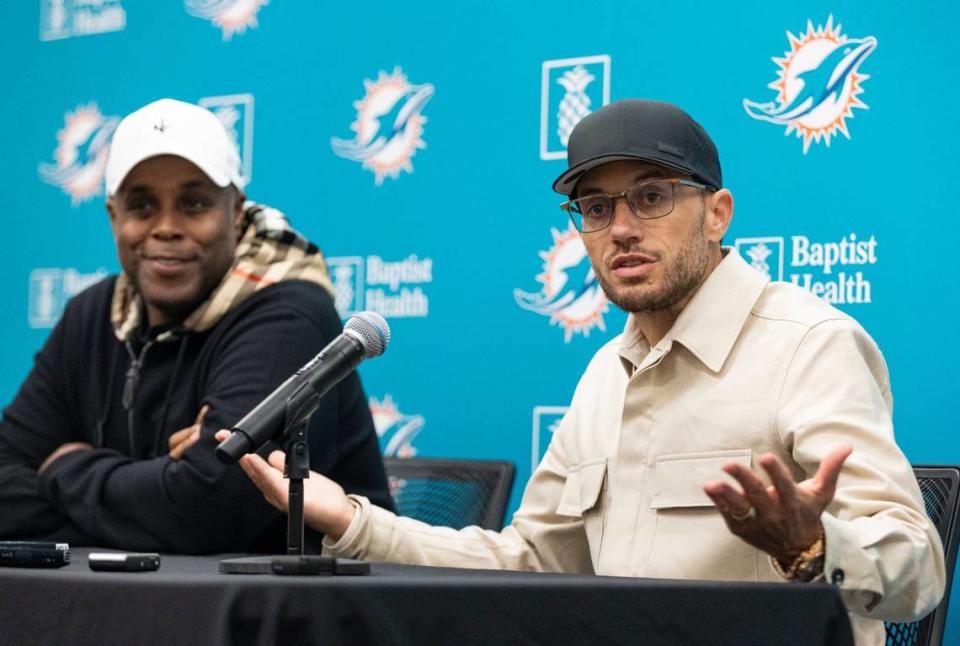Kelly: What’s the best way for Dolphins to spend the $18.5 million cutting Xavien Howard creates?

It’s officially refund season in the NFL.
On Saturday, teams that released a player with a June 1 designation will benefit from the cap savings created when they terminated an expensive player’s contract early, exercising a special designation designed to split up to two player’s salary cap charge over a two season period.
That means the on-a-budget Miami Dolphins — which spent this offseason purging salaries, restructuring contracts, allowing free agents to leave and signing less expensive replacements in an effort to get the team’s payroll in order — will receive $18.5 million in cap space from this spring’s release of cornerback Xavien Howard, a four-time Pro Bowl selection.
The funds finally hit Miami’s account, and there are a couple of ways South Florida’s NFL franchise can go about spending it.
Here’s a breakdown of the numerous options.
TAKING CARE OF THEIR OWN
The Dolphins can extend deals for players with expiring contracts, locking up young talent like they did signing Jaylen Waddle to a five-year, $105 million contract Thursday, which will likely keep the receiver in Miami until 2028.
Tua Tagovailoa and Jevon Holland sit atop the list of impending free agents, but there are smaller deals — like inside linebacker David Long Jr. or offensive lineman Liam Eichenberg — that could potentially get done.
Tagovailoa’s impending contract is extremely complicated because no matter how much the 26-year-old signs for, he will get the largest contract in franchise history if his future deal averages more than $40 million a season.
And a $40-million-a-season salary for a top-ranked quarterback such as Tagovailoa would be considered a bargain considering the contracts that the Atlanta Falcons gave Kirk Cousins ($45 million a year) and the Detroit Lions gave Jared Goff ($53 million) this offseason.
Expect Tagovailoa to clear $140 million in fully guaranteed money easily, which is the only figure that truly matters when it comes to NFL contracts.
Holland’s contract might be a bit more complicated because he hasn’t exactly had a breakout season in his first three years as an NFL starter. That makes nailing down a price point for his services complicated. The Patriots signed fellow safety Kyle Dugger to a four-year deal worth $58 million ($32.5 million in guaranteed money) after using the transition tag to prevent the 28-year-old from becoming an unrestricted free agent.
Holland hasn’t been as productive as Dugger, but he’s in the neighborhood.
Keep in mind, Tagovailoa’s extension would likely create cap space in 2024 because a new deal would lower his present cap hit, which comes from his $23.1 million fifth-year option.
An extension for Holland, who is slated to make $3.3 million this season, would reduce Miami’s cap space. How much depends on the size of the deal, and the signing bonus given.
ROOKIE DEALS MUST GET DONE
The Dolphins will need a little less than $2.8 million of the newfound cap space to sign the seven players drafted in 2024, and pass rusher Chop Robinson, who is due a four-year deal worth $14.97 million as the No. 21 pick in the 2024 draft, will be the most expensive.
The only other draftee that will count against the salary cap is second-round pick Patrick Paul, a left tackle expected to serve as Terron Armstead’s understudy this season. He’s due a four-year deal that’s worth $6.9 million.
The later-round picks — tailback Jaylen Wright, pass rusher Mohamed Kamara, safety Patrick McMorris and receivers Malik and Tahj Washington — fall below the threshold where their salaries have to count against the cap because they won’t have a top 51 salary slot. But all seven draftees will account for $8.3 million in cap charges in 2024.
FREE AGENCY ISN’T OVER
After next week’s mandatory minicamp concludes the Dolphins’ coaches and executives will sit down and discuss the 90-player roster, addressing areas of concern.
It’s hard to imagine the interior of the offensive and defensive line won’t be debated heavily since Miami hasn’t properly addressed the departure of defensive tackle Christian Wilkins, who signed four-year, $110 million deal with the Las Vegas Raiders, and offensive guard Robert Hunt, who signed a five-year, $100 million deal with the Carolina Panthers.
Miami would also benefit from the addition of a veteran safety because the top two backups — Elijah Campbell and Nik Needham — are both converted cornerbacks.
Accomplished veterans such as defensive lineman Calias Campbell, offensive lineman Phil Haynes and safeties Jamal Adams, Quandre Diggs and Justin Simmons remain free agents. While none of them seem to be in a rush to find a team, the Dolphins wouldn’t likely be viewed as an top destination for a veteran hoping to latch onto a playoff contender.
Some of those veterans can command salaries that pay $4 million plus.
The Dolphins annually sign at least half a dozen players between now and the start of the regular season, and some have become major contributors such as Eli Apple in the past.
BANKING THE SAVINGS
When Miami wasn’t spending every dollar the franchise had building a Super Bowl contender the franchise typically kept cap space available for emergency situations, like the signing of quarterback Jay Cutler in 2017 after Miami lost Ryan Tannehill for the season in training camp or executing a midseason trade, like the one that produced Bradley Chubb in 2022.
And what wasn’t used during the season was carried over to the next year, helping Miami balance the books. It’s super early, but next offseason the Dolphins are projected to be $15.6 million over the projected 2025 salary cap despite only having 50 players under contract And that’s before the seven rookies are signed, reducing the resources even further. While the team’s finances can easily be shifted around, every dime of cap space preserved helps.

 Yahoo Sports
Yahoo Sports 